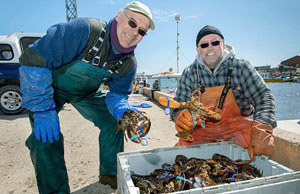The co-existence of whales and ships in the St. Lawrence Estuary sometimes results in fatal collisions for the animals. For the St. Lawrence Blue and Beluga Whale, two species with critical populations, the death of a few mammals represents a serious threat to their recovery. The situation was brought to the attention of the Government of Canada, marine industry partners and various organizations involved, who formed the Working Group on Marine Traffic and Protection of Marine Mammals. The objective: reducing the risk of collisions.

All news
Solid Collaboration to Protect Marine Mammals in the St. Lawrence Estuary 
|
Gaspé Lobster Fishers Leaving their Mark Since the start of the 2013 fishing season, Gaspé lobsters have been marked with a coded label identifying the fisherman who caught them, a procedure applied to all fishermen. This initial traceability procedure, from ocean to plate, gives consumers peace of mind in knowing that they are eating lobster from Quebec. 
|
The Sound of Ships in the St. Lawrence To improve our understanding of whales' acoustic environment in their habitat in the Estuary and Gulf of St. Lawrence, an acoustic observatory to monitor ships was installed in the Laurentian Channel off Métis-sur-Mer in November 2012. This observatory is measuring the noise emitted by ships transiting the St. Lawrence Seaway over a one-year period. 
|
Impressive Ivory Seizure In February, a team of fishery officers dedicated to the protection and conservation of Northern Quebec resources seized narwhal and walrus ivory in the areas of Montreal and Eastern Quebec. Narwhal and walrus are listed in the Convention on International Trade in Endangered Species of Wild Fauna and Flora, which Canada has signed. One of the key objectives of the Convention is to control the ivory trade. 
|
Hovercrafts: How Do They Work? You have probably seen them at work, especially in the spring, clearing ice jams to prevent flooding. They move easily on water, over flats and even on land. But how do these amphibious craft that seem to fly above everything really work? 
|
Working Together for the Recovery of Species at Risk The Channel Darter and the Eastern Sand Darter are two freshwater fish that are designated as threatened by the Committee on the Status of Endangered Wildlife in Canada (COSEWIC) and are on the list of species protected under the Species at Risk Act. 
|
Use Caution when Harvesting Shellfish With the arrival of spring and the ice melt, shellfish harvesting season kicks into high gear. But before hurrying to the beaches, it is a good idea to review regulations on safety and compliance to avoid fines. 
|
Individual Transferable Quota Program in the Lower North Shore Region Since the fall of 2011, the Association des pêcheurs de la Basse-Côte-Nord and Pêcheurs polyvalents Old Fort–Blanc Sablon have worked closely with Fisheries and Oceans Canada to implement an individual transferable quota program for the Greenland halibut fishery in the Lower North Shore region. 
|